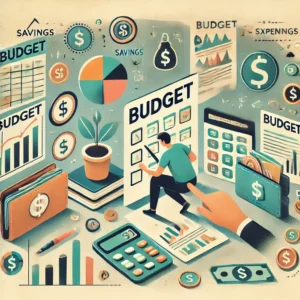Skip to Content
Advertisment

Budgeting Techniques to Improve Your Finance Management: A Comprehensive Guide
Introduction
- Definition of budgeting and its importance in finance management
- Brief overview of how budgeting helps individuals control their spending and achieve financial goals
- Explanation of the purpose of the guide and what readers can expect to learn

Step 1: Understanding the Basics of Budgeting
- What is budgeting?
- Definition of budgeting as a financial plan for managing income and expenses
- The role of budgeting in maintaining financial stability
- Why budgeting is crucial for financial success:
- Benefits of budgeting, including reduced financial stress, better savings, and control over spending
- How budgeting helps identify spending patterns and reduce unnecessary expenses
Step 2: Setting Clear Financial Goals
- Short-term and long-term financial goals:
- Examples of short-term goals (e.g., emergency fund, paying off small debts)
- Examples of long-term goals (e.g., retirement savings, buying a house)
- Aligning your budget with your goals:
- How to prioritize spending based on your financial goals
- Importance of setting SMART goals (Specific, Measurable, Achievable, Relevant, Time-bound)
Step 3: Tracking Your Income and Expenses
- Identifying all sources of income:
- Regular income (salary, wages) versus irregular income (freelance work, bonuses)
- Importance of including all income sources for accurate budgeting
- Categorizing expenses:
- Fixed expenses (rent/mortgage, utilities, insurance) vs. variable expenses (entertainment, dining out)
- Understanding discretionary vs. non-discretionary spending
- Using spending categories to analyze expenses:
- How to group expenses into categories for easier tracking and analysis
- Common categories include housing, transportation, groceries, utilities, healthcare, entertainment, and savings
Step 4: Choosing the Right Budgeting Technique
- The 50/30/20 Budget Rule:
- Explanation of the rule: 50% on needs, 30% on wants, and 20% on savings and debt repayment
- Benefits of using this method for balancing essential and non-essential expenses
- Examples of how to allocate expenses within this framework
- Zero-Based Budgeting:
- Definition of zero-based budgeting and how it works
- Allocating every dollar of income to a specific category, resulting in a zero balance
- The importance of planning each expense in advance to maximize savings
- Envelope System:
- Explanation of the cash-based envelope system and its purpose
- How to create envelopes for each spending category and stick to the allocated amounts
- Advantages of using this system to control impulsive spending
- Pay-Yourself-First Budget:
- Prioritizing savings by setting aside a fixed amount before addressing other expenses
- Importance of treating savings like a mandatory expense
- How this method encourages building an emergency fund and retirement savings
Step 5: Tools and Apps to Simplify Budgeting
- Budgeting apps and software:
- Overview of popular budgeting tools like Mint, YNAB (You Need A Budget), and PocketGuard
- Features of these apps that help track expenses, set goals, and receive alerts
- How technology can simplify the budgeting process and make it more effective
- Using spreadsheets for budgeting:
- How to create a simple yet effective budget spreadsheet using Excel or Google Sheets
- Advantages of customizing your own budget template to fit specific financial needs
- Step-by-step guide to building a basic budget spreadsheet
Step 6: Strategies to Stick to Your Budget
- Tips for staying disciplined with your budget:
- Importance of reviewing your budget regularly and making necessary adjustments
- How to set realistic spending limits that align with your financial goals
- Avoiding common budgeting pitfalls:
- The dangers of lifestyle inflation and how to avoid it
- How to resist the temptation of impulsive purchases and emotional spending
- Creating a financial accountability system:
- The benefits of having an accountability partner for your financial goals
- How to set up monthly or quarterly budget reviews to track progress
Step 7: Adjusting Your Budget as Needed
- Being flexible with your budget:
- Why it’s essential to adapt your budget based on changing financial situations
- How to handle unexpected expenses or changes in income
- Reevaluating financial goals:
- When to revise your goals to reflect life changes (job change, marriage, relocation)
- The importance of setting new milestones to stay motivated
Step 8: Building an Emergency Fund
- What is an emergency fund and why is it important?
- Definition of an emergency fund and its role in financial security
- Recommended amount to save in an emergency fund (typically 3-6 months of living expenses)
- How to build an emergency fund within your budget:
- Allocating a portion of your monthly savings to your emergency fund
- Strategies for rapidly growing your emergency savings in times of high income
Step 9: Reducing Expenses and Increasing Savings
- Identifying areas to cut back:
- Practical ways to reduce non-essential expenses like subscriptions, dining out, and shopping
- Techniques for saving on fixed expenses (negotiating bills, downsizing)
- Automating your savings:
- Setting up automatic transfers to savings or investment accounts
- Benefits of automating savings to ensure consistency and discipline
- Increasing your income:
- Exploring side hustles, freelance opportunities, and passive income streams
- How additional income can boost your savings and accelerate goal achievement
Step 10: Reviewing and Optimizing Your Budget Regularly
- Importance of regular budget reviews:
- How often you should review your budget to ensure it aligns with your goals
- Identifying trends in spending and making data-driven adjustments
- Using feedback to improve your budget:
- Learning from past mistakes to create a more effective financial plan
- Seeking ways to optimize budget categories for maximum efficiency
Conclusion
- Recap of the key budgeting techniques discussed in the guide
- Emphasis on the importance of discipline and consistency in budgeting
- Encouragement to start today to achieve better financial management and stability
Advertisment

